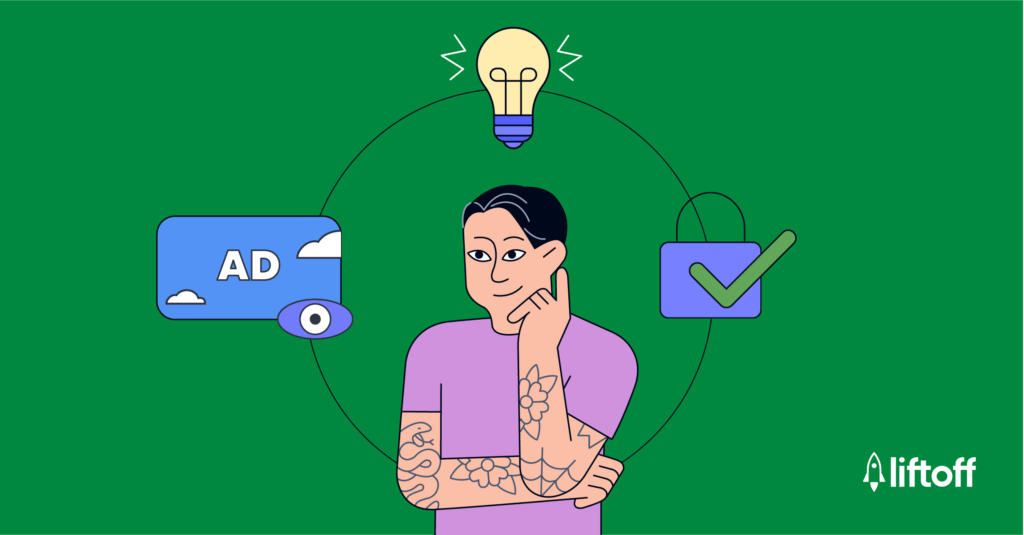
4 Strategies for Mobile Marketers in a Privacy-Centric World
In a 2019 study by the Pew Research Center, 59% of U.S. adults said they had little to no understanding of how companies used their collected data, and 79% of respondents said they were concerned about how that data is used. In a 2022 Ipsos poll, almost 80% of participants wanted to require companies to ask for consent before collecting data, and only 34% thought companies do a good job of keeping their personal information secure. This lack of trust is a key reason why today’s app users value data transparency more than ever.
Marketers can ease these concerns by adding transparent messaging on their apps about data collection and privacy. The message needs to clearly state the value of data collection, how that data is used, and where a user can manage their data settings. Educating users and providing them with transparent instructions on controlling their data both empowers them and builds trust.
Be transparent about data collection, build trust with users
After Apple rolled out ATT in 2021, conversations with mobile marketers have typically revolved around the privacy changes that limit third-party data access. ATT requires users to opt-in to data sharing with apps. For app marketers, this limits segmentation, attribution, and other insights into campaign performance. While overall ATT opt-in rates have steadily increased, rates can still vary significantly depending on app category.
Following Apple, Google plans to phase out its Advertising ID (GAID) by 2024 and to restrict cross-app tracking of users. But to ameliorate the impact of ID deprecation on user acquisition, Google is also developing its Privacy Sandbox for Andrdoid—similar to Apple’s SkAdNetwork(SKAN).
For iOS users, The Weather Channel (TWC) app excellently demonstrates transparent messaging that appears before the ATT prompt:
In this example, TWC explicitly states the value proposition of enabling tracking and data collection: users receive accurate weather forecasts for free. TWC also explains how tracking helps fund these forecasts, and then goes on to list the ways a user can learn more about their data collection settings and TWC’s privacy policy. The simple, concise language in this prompt has three major effects: it educates the user on the value of tracking, it demystifies how TWC collects the user’s data and where it can be managed, and, most importantly, it builds trust.
Effective messaging like this can be shown after the ATT prompt as well, reminding users of the value of data collection and how to enable it if they initially declined tracking but changed their minds later.
While Android currently does not face the same privacy challenges as iOS, app developers and marketers should still implement clear messaging around data collection as a best practice.
Put first-party data and ML to use
As both iOS and Android tighten restrictions on data collection, marketers must rely more heavily on first-party data. Often, this includes transactional data (install information, purchase history), demographical data, and behavioral data (user engagement).
Prioritizing first-party data in your marketing strategy allows you to better segment your audience and provide a more personalized ad experience. First-party data allows you to see how a customer moves across all your marketing channels and down the funnel. By pulling this data together, you can map the user journey more accurately and better segment your audience, optimize your strategy to impact user behavior, and increase conversions.
A trending strategy for 2023 includes relying more heavily on machine learning (ML) to optimize mobile marketing campaigns using first-party data. The Harvard Business Review predicts that artificial intelligence and machine learning use will more than triple over the next three years, growing from 12% usage to 38% usage among companies. The article states, “Marketers who integrate their first-party data with ML-driven marketing tech can optimize interactions with their most valued customers, rather than all customers, to drive the most valuable outcomes at the most efficient cost.”
Targeting the most valuable customers, or users with the best lifetime value (LTV), is immensely enhanced by implementing a first-party data strategy. Tools like LTV Optimize use first-party data to teach ML models how to target the same kinds of users proven to convert on your unique app. LTV Optimize allows marketers to make the most of their first-party data by more accurately and effectively targeting their most valuable users, optimizing their campaigns for the LTV window that fits their business needs, and generating the most revenue for their mobile campaigns.
Lean into brand marketing
As privacy restrictions limit the effectiveness of performance marketing campaigns, advertisers are pivoting their strategies to a more brand-centric approach.
According to an interview with Lucie Buisson, Chief Product Officer at Contentsqaure, strong branded campaigns use behavior and contextual data to create a personalized user experience that engages users and bolsters your app’s performance marketing goals. With better segmentation and personalized ads come happier, engaged users who are more likely to provide information you would not typically receive through mobile measurement partner (MMP) data, such as an email address. With data like these email addresses, advertisers can then create targeted performance marketing emails to send to the contacts they acquired through their branded campaigns. In this way, brand marketing has an indirect yet powerful impact on performance marketing.
To achieve this success, though, marketers must first address the 80% of customers complaining about a poor user experience while engaging with brands online. According to a recent Sitecore report, global consumers said that having an app or website that worked well on all mobile devices was the most important action a brand could take to create a seamless user experience. One of the easiest ways marketers can ensure their apps work well and provide customers with the optimal user experience is to focus on creative ad formats.
For branded campaigns, the best ad formats are the least invasive and the most engaging. While most marketers are quick to jump to videos because of their strong visual elements, it is important also to prioritize native ads in your brand marketing strategy. Native ads are the least invasive ad format and are made to look like a part of the app in which they are advertising. Both of these factors make native ads one of the most appealing ad formats to users and drive some of the highest engagement with brands.
If you decide to stick with video ads, be sure to include strong and compelling visuals and CTAs that drive multiple forms of engagement (taps, shakes, swipes, etc.) and demonstrate your brand’s value. Finally, incorporate interactive and playable ads into your mobile strategy. Interactive ads are the most engaging ad format, offering users the chance to preview your app and immerse themselves in the app experience. As an up-and-coming ad format, interactive ads offer a great opportunity to engage new users with your brand.
Diversifying channel mix and pivoting to adapt to ATT
In a privacy-centric world, in-app marketing is more complicated than ever before. SKAN 4.0 and the upcoming Google Privacy Sandbox developer kit will provide more information than earlier versions of SKAN, but both still lack the data marketers need to make informed decisions about their in-app advertising strategies. Marketers need to diversify their media mix and expand into other mobile channels to overcome these data hurdles.
App-to-web is probably the most interesting alternate channel. App-to-web is an ad campaign that leads users to mobile web pages. One of the main differences between app-to-web and traditional in-app advertising is the attribution method. Instead of using MMP data, app-to-web relies on a tracking pixel to collect user data.
At Liftoff, our Accelerate app-to-web campaigns collect user data and feed it into an ML model tailor-made to optimize mobile web conversions. Because Liftoff Accelerate has access to this first-party user data, it can attribute ad clicks to mobile web events in a privacy-friendly and ITP 2.3-compliant environment. As a result, app-to-web simultaneously allows app marketers to access key information they would not otherwise have, grow their user base, and optimize for mobile web conversions. An added bonus: purchases, subscriptions, and other revenue events from app-to-web campaigns are free from all app store fees that cut into marketers’ bottom lines.
Another key benefit of app-to-web campaigns is their excellent user experience for brand marketing. As mentioned above, more advertisers are shifting to brand marketing amidst privacy concerns and the need to improve their UX, according to 80% of consumers. App-to-web improves both the user ad experience and brand engagement for two reasons:
- App users tend to be more engaged than other online traffic to begin with.
- By redirecting users to a curated landing page, users are far more likely to stay on the page and engage with a brand than they would be on an app store page with limited design real estate.
Privacy and performance are not mutually exclusive
Although future privacy initiatives like SKAN 4.0 and the Google Privacy Sandbox show promise, mobile marketers can reap the benefits of a more-performant mobile campaign right away. Transparent mobile messaging about data collection, prioritizing first-party data with a machine-learning solution, building better user experiences for branded campaigns, and branching out into alternate mobile channels are great places to start.
If you want to learn more about driving performance while complying with privacy policies, get started with Liftoff today.


